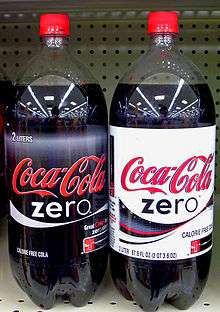Two-liter bottle
The two-liter bottle is a common container for soft drinks, beer, and wine. These bottles are produced from polyethylene terephthalate, also known as PET plastic, or glass using the blow molding process. Bottle labels consist of a printed, tight-fitted plastic sleeve. A resealable screw-top allows the contents to be used at various times while retaining carbonation.

In the United States, the two-liter bottle is one of the few cases where a product is sold by a round number of metric units. Since very few other beverages are sold in this exact quantity, the term "two-liter" in American English almost invariably refers to a soft drink bottle. Other common metric sizes for plastic soft drink bottles include 500 milliliters, 1 liter, and 3 liters.
History
PepsiCo introduced the first two-liter sized soft drink bottle in 1970.[1] Motivated by market research conducted by new marketing vice president John Sculley (who would later be known for heading Apple Inc. from 1983 to 1993),[2] the bottle and the method of its production were designed by a team led by Nathaniel Wyeth of DuPont, who received the patent in 1973.[3] In 1985, a three-liter bottle appeared on supermarket shelves. The design is still used to this day by some bottlers.[4][5]
Most modern-day two-liter bottles are one piece of PET (polyethylene terephthalate) with a base that is molded with a radial corrugation to provide strength for the bottom and the ability to stand upright. Most early two-liters had a separate opaque base glued to the hemispherical bottom of the clear PET flask. This base had a coaxial corrugation and drain holes. It was abolished in the 1990s, in part due to difficulties recycling the two separate plastics.
Recycling
Used two-liter bottles see new life in a variety of uses including carpeting, boat hulls, polyester fabric, filling for jackets, sleeping bags, mattresses, pillows, recycling bins, scouring pads, and, on an increasing scale, new soft drink bottles.[6]
Specifications
Typical dimensions:[7]
- Height ~327 mm (12.9 in)
- Diameter ~104 mm (4.1 in)
See also
- Container deposit legislation
- Metrication in the United States
- Plastic bottle
References
- "PepsiCo – Company – History". PepsiCo. 2006.
- Sculley, John (2014). Moonshot!. RosettaBooks. p. 68. ISBN 9780795343360.
- Nathaniel C. Wyeth (15 May 1973). "US Patent 3733309 Biaxially Oriented Plastic Bottle". Retrieved 2007-02-19 – via Google.com.
- Maidenberg, H. J. (January 13, 1985). "PROSPECTS; Endangered Species". The New York Times. Retrieved May 26, 2010.
- "Alabama Business Hall of Fame to Celebrate 25th Anniversary". C&BA News. September 30, 1998. Archived from the original on September 5, 2006.
- "Best Practices and Industry Standards in PET Plastic Recycling" (PDF). NAPCOR. 2003. Archived from the original (PDF) on 2006-06-20.
- "2 ltr Round PET Standard Water Bottle 28mm neck".